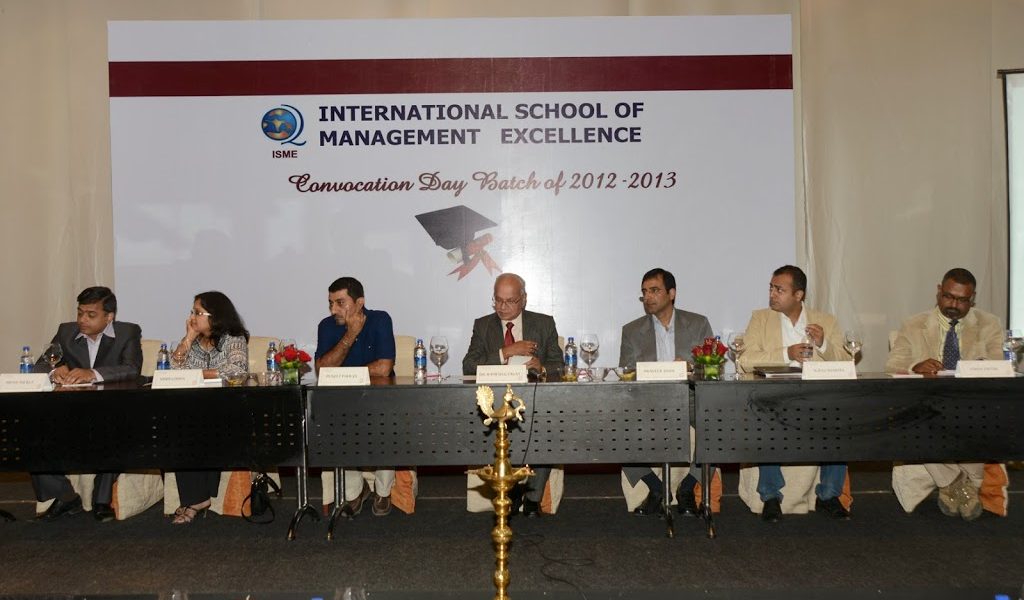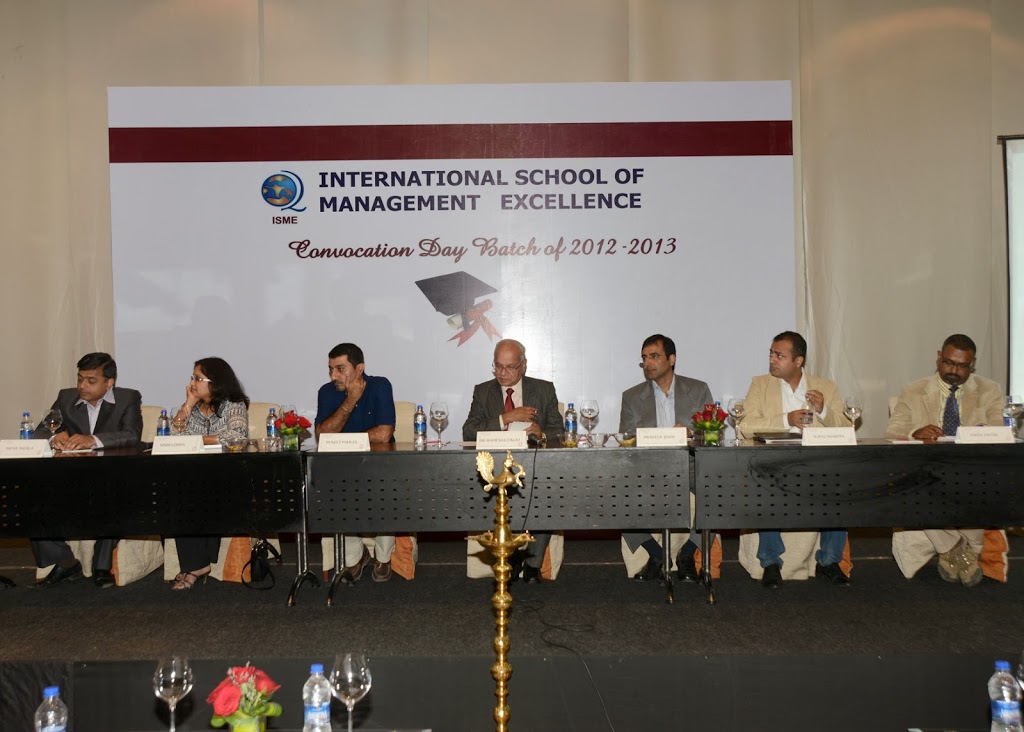A panel discussion was conducted in the forenoon of the convocation day of the outgoing batch of students of International School of Management Excellence (ISME) on 23rd February, 2014. Prof. Ramesh G. Tagat, Academic Mentor – ISME chaired the session and the topic of discussion was “Corporate Experiences: Managing Social Media & Use of Analytics”.
The panelists who participated belonged to a very diverse and progressive corporate world:
Anish Jacob: Consultant, Digital Analytics Solutions, Nabler
Arpan Shukla: Head, Employee Life Cycle Management, HRD, Tata Teleservices
Nidhi Lodha: AVP, Social Media Research, Genpact
Praveer Joshi: Director, Business Analytics, Dell
Puneet Pahuja: Founder & CEO, Webenza India (P) Ltd
Suraj Kumar Sharma: Senior Brand Manager, SAB Miller India
Prof. Tagat initiated the discussion as he sought the following from the panelists: experiences with social media and its role in fulfilling the business objectives and in the design of marketing strategy, its influence on diverse communities across various platforms, the measurability of its impact on business goals, actionable insights & financial performances.
Mr. Pahuja talked about the major objectives of using social media which include: creating awareness, generating leads, thought leadership, branding & market optimization. The strategic actions that need to be taken for achieving the above objectives are to track conversations, understand the target segments, select channels, hire corresponding personnel who have the necessary ability to play a creative & technological role and using relevant metrics for measurement. He also mentioned about the need to connect humanely with consumers through mobile applications at emotional levels.
Mr. Praveer Joshi of Dell looked at social media from two perspectives – 1) what it means to big companies like Dell & 2) how it is understood by them from the analytics perspective. He explained it by differentiating social media from traditional media wherein the former follows a ‘listen & sell’ approach as compared to the ‘sell & respond’ approach of the latter. The other factor was the amplification or speedy dispersion of information on the social media. The Dell community forums provide insights into the experiences, opinions and the latest on Dell products & services and other technological developments happening in the current scenario. Net promoter Score (NPS) & Customer Satisfaction Score (CSS) are some of important methods adopted for measuring the impact of social media on buying behavior.
Nidhi Lodha of Genpact explained the whole concept in modular forms. She stated that data is characterized by volume, variety & velocity. Genpact sees itself on the service side of the social media, that involved listening (consumers, competitors & regulatory bodies), learning (understanding sentiments, top of mind, products buzz, thematic analysis) and engaging at various levels (with key influencers, consumers). She also mentioned that leading players like Dell have installed a command center that surveys and responds to its consumers online.
Suraj Sharma of Sab Miller described social media as another media channel to be adopted alongside other channels of communications. It is a user centric media that permits engagement and leads to amplification. The viral potential of this media is such that an ad on You Tube will achieve a reach that is 12 times that of a TV ad. It is tactical tool that can used for an ad hoc promotional drive in the short term and may be used as strategic tool for brand building in the long term. He also mentioned that is important to build and be part of virtual communities leading to a continuous and rewarding interaction with stakeholders. The digital media spend is about 5% to 10% of the total promotion budget for FMCG products; it complements the main channels and is poised to expand and grow. The measurement of impact of social media has to be done on a continuous basis and the choice of variables is the key to successful measurement and control.
Anish Jacob of Nabler stressed on the importance of training personnel to handle social media communications. They had developed a REAN (Reach, Engage, Activate and Nurture) model for engaging and nurturing their customers on long term basis. He discussed the 3-P framework being used in their organization for their clients: platform, processes and people presented in an inverted pyramid form with people at the top. He elaborated on it by stating that if 100% was the spending on analytics then 10% should be the spend on platform & processes and 90% on people.
Arpan Shukla of Tata
Teleservices gave an interesting insight from the competitor’s perspective when he mentioned that their telecom revenue came down drastically by nearly 16% and their international revenue by 10% by the onslaught of social media. So they decided to get on to social networks to get back their customers and that resulted in the increase of revenue by 11%. His mantra was respect the competition and go ahead of it. Hence social media is an excellent channel for managing customer relations and also for brand building.
Teleservices gave an interesting insight from the competitor’s perspective when he mentioned that their telecom revenue came down drastically by nearly 16% and their international revenue by 10% by the onslaught of social media. So they decided to get on to social networks to get back their customers and that resulted in the increase of revenue by 11%. His mantra was respect the competition and go ahead of it. Hence social media is an excellent channel for managing customer relations and also for brand building.
The discussion ended with answers to some relevant questions related to the control of negative word of mouth and also the creative skills required for employability in this field. The discussion was briefly summarized by ISME Director, Mr. Nitin Garg. The conclusion drawn was that social media is definitely an additional channel for communications alongside others forms and is an excellent mode of continuous engagement with customers that needs to be continuously controlled and monitored.
Rema Vishwanathan





